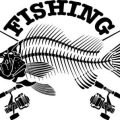1. Spring Fishing: Gearing Up for Active Bites
As winter loosens its grip and water temperatures begin to rise, fish across the U.S. become more active and start moving into shallow waters to feed and spawn. Spring is one of the most exciting times of year to fish, especially for species like largemouth bass, smallmouth bass, and trout. To make the most of this season, choosing the right reel is key.
Top Targets in Spring
Different fish species react differently as spring arrives. Here are a few popular springtime targets and what makes them unique:
| Species | Behavior in Spring | Ideal Reel Type |
|---|---|---|
| Largemouth Bass | Move into shallow waters for spawning; aggressive strikes common | Baitcasting Reel |
| Smallmouth Bass | Found near rocky shorelines; respond well to jigs and crankbaits | Baitcasting or Spinning Reel |
| Trout (Rainbow, Brown, Brook) | Feeding actively in streams and rivers as insects hatch | Spinning Reel or Fly Reel (for fly fishing) |
| Panfish (Bluegill, Crappie) | Schooling in warm shallows; great for light tackle fishing | Ultralight Spinning Reel |
Best Reels for Spring Fishing Conditions
Spring conditions often mean varying water clarity, increased vegetation, and unpredictable weather. Youll want a reel that offers versatility and smooth drag performance to handle these changes.
Baitcasting Reels: Control & Power
Baitcasters are ideal when targeting larger species like bass that strike hard and put up a fight. They offer excellent casting accuracy around cover like submerged logs or grassy banks where fish may be spawning.
Recommended Features:
- Low-profile design for comfort during long casting sessions
- Smooth drag system to control strong springtime runs
- High gear ratio (6.4:1 or higher) for faster retrieves
Spinning Reels: Versatility & Ease of Use
If youre new to fishing or targeting lighter species like trout or panfish, spinning reels are your best bet. Theyre user-friendly and great for casting lightweight lures with precision.
Recommended Features:
- Anti-reverse feature to prevent handle backplay when setting the hook
- Braid-ready spool for increased line capacity if needed
- Sized appropriately—2000-3000 range for trout and panfish, 3000-4000 for bass
Fly Reels: For Traditional Trout Anglers
If you’re hitting the mountain streams of Colorado or the clear waters of Montana in spring, a fly reel paired with a matching rod is perfect for presenting flies to feeding trout during hatches.
Recommended Features:
- CNC-machined aluminum construction for durability and light weight
- Smooth disc drag system to protect light tippets from breaking on sudden runs
- Balanced with your fly rod setup (check weight ratings)
Quick Tips for Spring Reel Setup
- Line Selection: Use fluorocarbon for clear water visibility or braided line with a fluoro leader near heavy cover.
- Lubrication: After winter storage, ensure your reels are cleaned and lightly oiled before use.
- Tuning Drag: Set your drag properly based on target species—tight enough to set the hook but loose enough to avoid breakoffs.
The right reel can make all the difference in spring when fish are hungry and active. Whether youre flipping jigs into bass beds or drifting worms through a trout stream, matching your reel choice to your target species will help you land more fish this season.
2. Summer Challenges: Beating the Heat with the Right Reel
When summer hits in the U.S., anglers face a new set of challenges—rising temperatures, deeper waters, and more aggressive fish. Whether youre fishing off the Gulf Coast or exploring freshwater lakes in the Midwest, your reel needs to be as tough as the conditions youre facing.
Durability Matters Under the Sun
Summer heat can wear down gear faster than other seasons. That’s why it’s essential to choose reels built with corrosion-resistant materials like anodized aluminum or stainless steel. These materials not only handle the suns intensity but also stand up against saltwater spray during coastal trips.
Go Big on Capacity for Deep Water Fishing
Warmer weather often pushes fish into deeper waters where oxygen levels are more stable. In these conditions, you’ll want a high-capacity spinning or conventional reel that can hold plenty of heavy line, especially if youre targeting large species like tuna, mahi-mahi, or grouper offshore.
Recommended Summer Reels by Fishing Type
| Fishing Environment | Recommended Reel Type | Key Features |
|---|---|---|
| Saltwater Offshore | Conventional Reel (High-Capacity) | Strong drag system, corrosion resistance, deep spool capacity |
| Freshwater Lakes | Baitcasting Reel | Precision control, smooth retrieval, good for bass and pike |
| Inshore Saltwater | Spinning Reel (Medium-Heavy) | Lightweight, anti-corrosion coating, fast retrieve rate |
Tackling Aggressive Species in Peak Conditions
Fish are most active during summer months, which means stronger fights and longer battles. Look for reels with robust drag systems that can handle powerful runs without overheating or locking up. Dual drag or carbon fiber drag systems are great choices when going after redfish, tarpon, or striped bass.
Pro Tip:
If youre heading out during peak sun hours, carry a backup reel and keep it shaded or covered when not in use. This helps prevent heat-related gear failure and keeps you fishing longer.
Choosing the right reel for summer is all about durability, capacity, and strength. With the right setup, youll be ready to take on whatever bites beneath those sunny American waters.

3. Fall Fishing: Adapting to Changing Patterns
As the days grow shorter and water temperatures begin to drop, fish start transitioning into their winter behavior. Fall is a time of change — both in nature and in fishing patterns. To stay successful on the water, anglers need reels that can keep up with these shifting conditions. Choosing the right reel for fall means focusing on versatility, smooth drag systems, and gear ratios that allow you to adjust quickly to different fishing tactics.
Why Reel Choice Matters in Fall
During fall, many species like bass, walleye, and trout become more active as they feed heavily before winter. However, their locations and feeding habits can vary greatly depending on the region and weather changes. A good reel should help you cover more water efficiently while offering precise control during those sudden bites.
Key Features to Look for in a Fall Reel
- Smooth Drag System: As fish become more aggressive, a smooth and consistent drag helps prevent line breakage during hard runs.
- Versatile Gear Ratio: Look for gear ratios between 6.2:1 and 7.1:1, which offer a balance between power and speed — ideal for switching between slow retrieves and fast-moving baits.
- Durability: With changing weather conditions, reels should be resistant to moisture and cold-weather corrosion.
Recommended Reel Types by Fishing Style
| Fishing Style | Recommended Reel Type | Why It Works |
|---|---|---|
| Bass Fishing with Crankbaits | Baitcasting Reel (6.4:1 Gear Ratio) | Offers strong control for casting accuracy and allows quick retrievals when targeting active fish near structures. |
| Walleye Jigging | Spinning Reel (5.2:1 Gear Ratio) | Sensitive enough for light bites while providing smooth drag for sudden pulls. |
| Trout in Streams or Lakes | Ultralight Spinning Reel | Lighter setups work best with smaller lures during fall hatches; look for smooth drags to handle quick surges. |
Pro Tip:
If youre fishing in areas with unpredictable fall weather, consider using reels with sealed components to protect from dirt, rain, and fluctuating temperatures.
Selecting the right reel during the fall season not only improves your success rate but also enhances your overall experience by making each cast smoother and every fight more controlled.
4. Winter Strategies: Cold-Weather Reels That Perform
Fishing in winter brings a whole new set of challenges—freezing temperatures, icy water, and fish that are far less active than in warmer months. To make the most out of your winter fishing trips, choosing the right reel is essential. In this section, we’ll explore reels best suited for ice fishing and cold-weather angling across the U.S., focusing on durability, simplicity, and ease of use—even when youre wearing thick gloves.
What Makes a Reel Great for Winter?
Not all reels are built to handle sub-zero conditions. Here are key features to look for:
- Durability: Cold weather can cause cheap plastics and metals to crack or seize up. Look for reels made with high-quality materials like graphite or anodized aluminum.
- Simplicity: Fewer moving parts mean less chance of mechanical failure in freezing temps.
- Glove-Friendly Design: Oversized knobs and handles make it easier to adjust settings without taking off your gloves.
Top Reel Types for Winter Fishing
The following table breaks down popular reel types used during winter and their pros and cons:
| Reel Type | Best For | Pros | Cons |
|---|---|---|---|
| Inline Ice Fishing Reels | Panfish, Crappie, Bluegill under ice | No line twist, smooth drop, great for finesse fishing | Limited drag power, not ideal for larger species |
| Spinning Reels (Ice-Specific Models) | Bass, Trout, Walleye through ice holes | Versatile, easy to use, good drag systems | Can freeze up if not properly maintained |
| Baitcasting Reels (Cold-Rated) | Larger species in open cold water (not ice) | Strong drag and control for bigger fish | Difficult to operate with gloves, steeper learning curve |
Recommended Features for Cold-Weather Reels
- Lubrication: Choose reels with low-temp grease or oil to prevent freezing.
- A Sealed Drag System: Keeps moisture out and ensures smooth performance in icy environments.
- Smooth Drag Adjustment: Lets you fine-tune resistance even with limited finger mobility.
- Simplified Bail Systems: Reduces chances of mechanical failure or ice build-up.
User Tips: Keeping Your Reel Winter-Ready
- Avoid Over-Lubrication: Excess oil can gum up in freezing temps—use only whats needed.
- Ditch the Water: After each outing, dry your reel completely to prevent internal freezing.
- Tape It Up: Cover vents or exposed areas with waterproof tape to block snow and slush.
Tried-and-True Winter Reel Picks (Angler Favorites)
| Brand & Model | Main Use | User-Friendly Features |
|---|---|---|
| Piscifun ICX Precision Inline Reel | Panfish Ice Fishing | Sensitive drag system, anti-freeze lubrication, glove-friendly handle |
| KastKing Royale Legend II Baitcaster (Cold Version) | Larger freshwater species in cold open waters | Anodized frame, low-temp bearings, oversized knobs |
| Celsius Blizzard Spinning Reel | Icy lake and pond fishing across Midwest/Northern states | Simplified design, pre-lubed for freezing temps, budget-friendly option |
Selecting the right reel for winter isn’t just about performance—it’s about making sure you enjoy your time on the ice instead of fighting frozen gear. Keep it simple, rugged, and user-friendly so you can focus on what matters most: landing that catch in the dead of winter.
5. Maintenance and Seasonal Reel Prep
Keeping your fishing reel in top shape throughout the year isn’t just about performance—it’s about protecting your investment. Each season in America brings different challenges, from spring rains to winter freezes. Regular cleaning, proper storage, and seasonal prepping can help you get the most out of your reel whether youre chasing bass in summer or ice fishing for perch in winter.
Cleaning Your Reel by Season
Your reel needs different types of care depending on the time of year. Heres a quick breakdown of how to clean it based on each season:
| Season | Cleaning Tips |
|---|---|
| Spring | Rinse off any pollen or early-season dirt with fresh water. Lubricate moving parts and check for rust from winter storage. |
| Summer | Sweat, sunscreen, and dusty trails can gunk up reels fast. Wipe down after every trip, especially if youre fishing saltwater. |
| Fall | This is a great time for a deep clean. Strip the reel, remove old grease, and reapply fresh lubricant before storing or switching setups. |
| Winter | If youre ice fishing, make sure reels are dry and lightly lubed with cold-weather grease. Avoid over-lubricating—it can freeze up parts. |
Storage Tips by Season
A little thought into how you store your reels can prevent damage and keep them ready to go when the next bite hits.
Spring & Summer Storage
- Avoid leaving reels in hot cars—excess heat can warp plastic components and break down lubricants.
- If not used frequently, cover your reel with a cloth bag to protect it from dust and UV rays.
Fall Storage Prep
- This is the perfect time to inspect line condition, tighten screws, and replace any worn parts before the offseason.
- If youre ending your fishing season here, store reels indoors in a dry spot like a closet or gear room—not in the garage where temperature swings are common.
Winter Care & Ice Fishing Considerations
- If using reels in sub-zero temps, switch to low-temperature lubricants made for ice fishing reels.
- If storing for winter, remove the line (especially monofilament) to prevent memory curls come spring.
- Avoid storing reels with tension on the drag system—loosen drag knobs before putting them away.
Your Seasonal Reel Prep Checklist
| Task | Description | Best Time to Do It |
|---|---|---|
| Lubricate Gears & Bearings | Add oil/grease to key points for smooth operation. | Start of Spring & Mid-Fall |
| Tighten Screws & Handle Connections | Avoid loose parts that could fall off while casting or retrieving. | Every Season Change |
| Cleansing Drag System Discs | Dirt here affects performance under pressure—clean gently with a Q-tip and alcohol if needed. | Semi-annually (Spring & Fall) |
| Dismantle & Deep Clean Reel Body | Takes more effort but gives insight into internal wear-and-tear. | Mainly Fall; optional mid-Summer if heavily used. |
| Spoil New Line (if Needed) | If line memory or fraying occurs, respooled reels give better casting distance and accuracy. | Bass season (Spring/Summer) or Ice Fishing (Winter) |
Treat Your Reel Like You Treat Your Truck—With Respect!
No matter what region of America youre fishing—from the Great Lakes to the Gulf Coast—the best anglers know that taking care of their gear is half the battle. With these seasonal maintenance tips, your favorite reel will be ready whenever you hear that first splash or see that bobber twitch. Keep it clean, keep it lubed, and itll reward you with years of reliable casts and smooth retrieves season after season.


